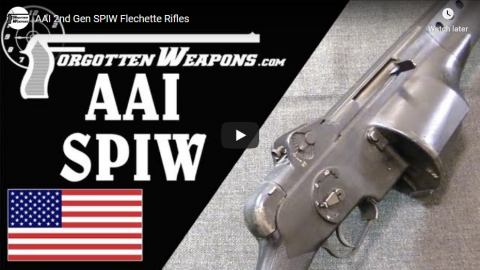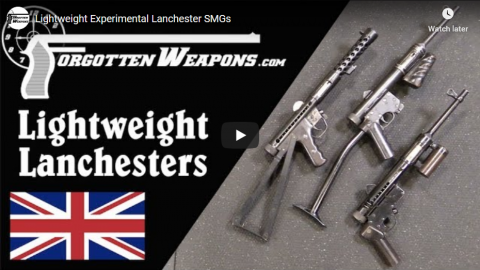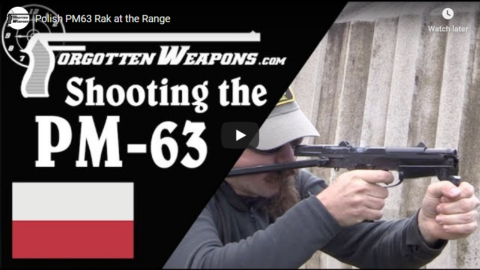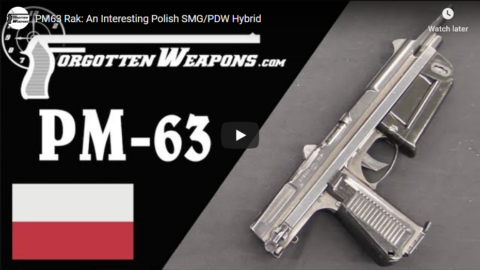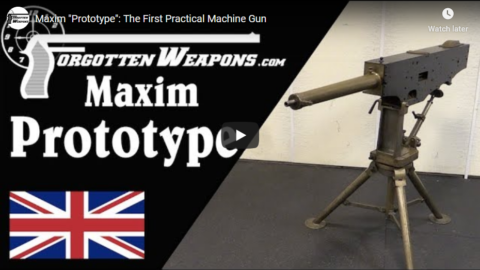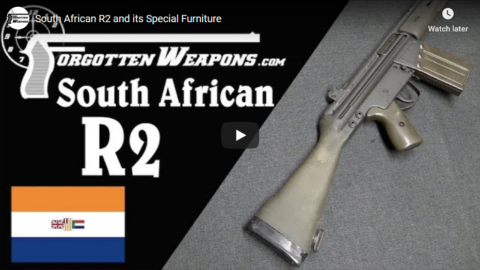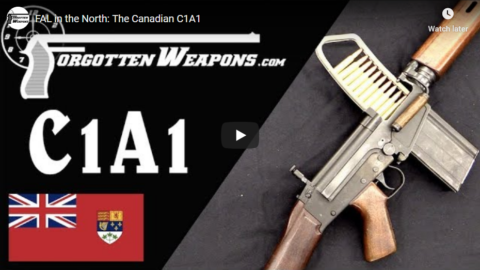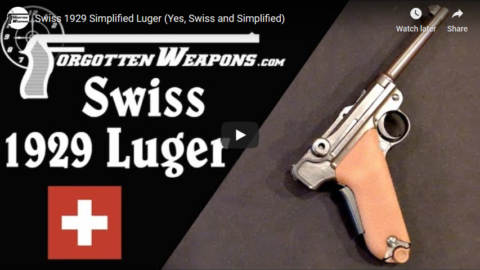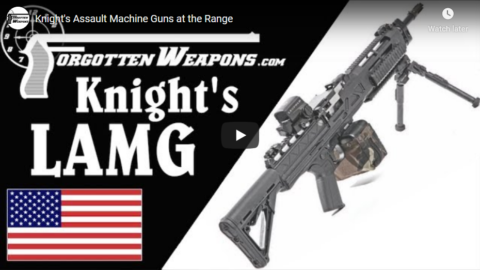Forgotten Weapons
Published on 24 Jun 2019http://www.patreon.com/ForgottenWeapons
Cool Forgotten Weapons merch! http://shop.bbtv.com/collections/forg…
The SPIW program began in 1962 with entries from Colt, Springfield, AAI, and Winchester. The first set of trials were a complete failure, and both Colt and Winchester abandoned the project at that point. AAI pressed on, producing these second generation rifles – one for trials in 1966 and one after. Both are chambered for the XM-645 5.6x57mm single-flechette cartridge. Under testing, both showed multiple serious problems in reliability, noise, cook-offs, and accuracy. The company would struggle on for years continuing to develop the flechette rifle system, but would be ultimately unsuccessful.
Thanks to the Rock Island Arsenal Museum for allowing me access to film this very interesting rifle! If you are in the Quad Cities in Illinois or Iowa, the Museum is definitely worth a visit. They have a great number of small arms on display as well as an excellent history of the Rock Island Arsenal.
http://www.arsenalhistoricalsociety.o…
Contact:
Forgotten Weapons
PO Box 87647
Tucson, AZ 85754
August 18, 2019
AAI 2nd Gen SPIW Flechette Rifles
August 15, 2019
How Does it Work: Stoner’s AR System
Forgotten Weapons
Published on 18 Jun 2019http://www.patreon.com/ForgottenWeapons
Cool Forgotten Weapons merch! http://shop.bbtv.com/collections/forg…
Eugene Stoner’s AR-10 and AR-15 use an operating mechanism that is often called “gas impingement,” but which is actually a cleverly structured gas piston located within the bolt carrier. Gas is tapped from the barrel and moved all the way back to just behind the chamber, where it enters the bolt carrier. There the carrier and bolt act as the two parts of a sealed piston, and when the bolt carrier moves rearward the cam pin forces the bolt head to rotate and unlock. The expanding gas is then vented out through holes in the side of the bolt carrier. By locating the piston on the same axis as the barrel, the harmonics are improved and the overall weight of the gun can be reduced by using the gas piston elements as mass in the bolt carrier assembly. Contrary to the old adage “it shits where it eats,” the operating gasses are not vented into the magazine or chamber, and the system has proven to be very reliable.
Contact:
Forgotten Weapons
PO Box 87647
Tucson, AZ 85754
August 12, 2019
At the Range with the Iconic MP5A3
Forgotten Weapons
Published on 15 Jun 2019http://www.patreon.com/ForgottenWeapons
Cool Forgotten Weapons merch! http://shop.bbtv.com/collections/forg…
The MP5 is widely considered the best submachine gun ever made, for its reliability, its handling, and its closed-bolt delayed-blowback action. It is so widely praised, in fact, that H&K’s efforts to replace it with less expensive polymer submachine guns have largely failed, as their customers simply insist on the MP5.
I have had only a brief bit of experience actually using the MP5 myself, and I wanted to take this opportunity while visiting H&K to fix that. So, does it live up to its reputation?
In a word, yes.
Many thanks to H&K USA for providing me access to this MP5A3, and to Trijicon for graciously providing use of their range!
Contact:
Forgotten Weapons
PO Box 87647
Tucson, AZ 85754
August 9, 2019
Lightweight Experimental Lanchester SMGs
Forgotten Weapons
Published on 14 Jun 2019http://www.patreon.com/ForgottenWeapons
Cool Forgotten Weapons merch! http://shop.bbtv.com/collections/forg…
George Lanchester was the engineer responsible for originally reverse engineering the German MP28 submachine gun for production by the British, under the designation Lanchester. Once he finished that design work, the gun was put into production by the Sterling Engineering Company, and Lanchester went to work for them as part of the manufacturing process. Once there, he began tinkering with improved designs to reduce the weight of the gun – one of its main drawbacks. He created these three prototypes, but went no further, as government officials ordered him to stop when they discovered this work in 1942. By that time the Sten was in production, and continued development of the Lanchester was seen as a waste of time and resources.
The guns remained in the Sterling company’s reference collection, and elements of the final stock design would resurface in a later prototype design in the 60s. Beyond that, these guns were a simple dead end of design.
Many thanks to the Royal Armouries for allowing me to film and disassemble these unique submachine guns! The NFC collection there – perhaps the best military small arms collection in Western Europe – is available by appointment to researchers:
https://royalarmouries.org/research/n…
You can browse the various Armouries collections online here:
https://royalarmouries.org/collection/
Contact:
Forgotten Weapons
PO Box 87647
Tucson, AZ 85754
August 6, 2019
How Does it Work: Gas-Delayed Blowback
Forgotten Weapons
Published on 11 Jun 2019http://www.patreon.com/ForgottenWeapons
Cool Forgotten Weapons merch! http://shop.bbtv.com/collections/forg…
Gas-delayed blowback is a relatively uncommon operating system used in handguns. It is not an efficient mechanism for high-pressure rifle power cartridges, but works well with something like 9mm Parabellum. It tends to provide benefits of light felt recoil and better-than-average accuracy, in exchange for overheating much more quickly than other systems.
Contact:
Forgotten Weapons
PO Box 87647
Tucson, AZ 85754
August 3, 2019
Polish PM63 Rak at the Range
Forgotten Weapons
Published on 8 Jun 2019http://www.patreon.com/ForgottenWeapons
Cool Forgotten Weapons merch! http://shop.bbtv.com/collections/forg…
Whether it is described as a machine pistol, a submachine gun, or a personal defense weapon, the PM63 Rak is really not the best examples of this sort of thing to actually shoot. The open-bolt/slide mechanism is very cool from an engineering and design perspective, but does in fact have a tendency to hit one in the face, as inadvertently demonstrated by my high-speed video shooting volunteer. Even if it doesn’t do that, the sights reciprocating on the slide make it a difficult gun to shoot accurately.
Thanks to Movie Armament Group in Toronto for giving me the opportunity to take this to the range! Check out MAG on Instagram: https://instagram.com/moviearmamentsg…
Contact:
Forgotten Weapons
PO Box 87647
Tucson, AZ 85754
August 2, 2019
PM63 Rak: An Interesting Polish SMG/PDW Hybrid
Forgotten Weapons
Published on 7 Jun 2019http://www.patreon.com/ForgottenWeapons
Cool Forgotten Weapons merch! http://shop.bbtv.com/collections/forg…
The PM-63 Rak is a pretty interesting Polish Cold War machine pistol or personal defense weapon. It fires from an open bolt, but uses a slide like a pistol rather than a bolt in an enclosed receiver like a typical SMG. There are several other interesting elements to the design, so let’s take a closer look…
Thanks to Movie Armament Group in Toronto for giving me the opportunity to bring you this video! Check out MAG on Instagram: https://instagram.com/moviearmamentsg…
Contact:
Forgotten Weapons
PO Box 87647
Tucson, AZ 85754
August 1, 2019
Maxim “Prototype”: The First Practical Machine Gun
Forgotten Weapons
Published on 31 Jul 2019http://www.patreon.com/ForgottenWeapons
Cool Forgotten Weapons merch! http://shop.bbtv.com/collections/forg…
Hiram Maxim was the first person to create a truly practical and functional machine gun, based on a patent he filed in 1883. He pioneered the recoil operating system – the concept of harnessing the recoil generated by a firearm to perform the actions of reloading that firearm. His patent was based on a lever action rifle, but his intent was to create a machine gun, complete with belt feed and water cooling. After a testbed “forerunner” gun, he built this model which he called the “Prototype”. It was meant as a proof of concept, and used in many public exhibitions and demonstrations.
The Prototype used a hydraulic rate of fire control system which could be set as high as 500 rounds/minute and as low as just one round per minute. The gun did not have a trigger as we would recognize it today, but rather a single lever like a vehicle accelerator which acted as both trigger and fire rate control. Only three of these Prototypes exist today, with one belonging to the USMC, one on public display at the Royal Armouries museum in Leeds, and this one in the NFC reserve collection at Leeds.
For a fantastic exploded view of all this guns working parts, check out this work by YouTube channel vbbsmyt:
Many thanks to the Royal Armouries for allowing me to film this tremendously important artifact! The NFC collection there — perhaps the best military small arms collection in Western Europe — is available by appointment to researchers:
https://royalarmouries.org/research/n…
You can browse the various Armouries collections online here:
https://royalarmouries.org/collection/
Contact:
Forgotten Weapons
PO Box 87647
Tucson, AZ 85754
July 29, 2019
South African R2 and its Special Furniture
Forgotten Weapons
Published on 5 Jun 2019http://www.patreon.com/ForgottenWeapons
Cool Forgotten Weapons merch! http://shop.bbtv.com/collections/forg…
In South African military service, the R1 was the FN FAL and was the preferred infantry combat rifle until the adoption of the Galil as the R4 rifle. So what were the guns in between? Well, the R2 was a South African adaptation of the G3. A large number of rifles were needed as a reserve, and also to equip second echelon units like the Air Force, Cape Corps, and South West Africa Territorial Force. To reduce the expense of this, South Africa purchased something like 100,000 G3 rifles from Portugal and designated them R2.
The Portuguese hand guards and buttstocks were found to be unsatisfactory, however. In the heat and harsh ultraviolet radiation of South West Africa (now Namibia) in particular, the plastic would shrink and lose its fit, leading to the guns being called “rattlers” by the SADF troops. The fix this, the American firm of Choate Machine & Tool was contracted to make new hand guards based on the H&K export pattern — wider and longer and with fittings for a bipod. New stocks were also made, duplicating the shape of the R1/FAL stock.
Contact:
Forgotten Weapons
PO Box 87647
Tucson, AZ 85754
July 26, 2019
How Does it Work: Blow Forward
Forgotten Weapons
Published on 28 May 2019http://www.patreon.com/ForgottenWeapons
Cool Forgotten Weapons merch! http://shop.bbtv.com/collections/forg…
The blow forward system has only been used on three commercially-produced firearms: the Schwarzlose 1908, Hino-Komuro, and Mannlicher 1894 (The SIG AK-53 uses a forward barrel movement, but in conjunction with a locked breech). It offers a simple system with a theoretical extra margin of safety because the side cannot come backward off the gun, but at the cost of substantially increased felt recoil. Once the blowback system was out of patent protection, there was no convincing reason to use the blow forward mechanism.
Contact:
Forgotten Weapons
PO Box 87647
Tucson, AZ 85754
July 23, 2019
How Does It Work: Direct Gas Impingement
Forgotten Weapons
Published on 21 May 2019Interested in small arms history? Make sure to pre-order a copy of my book, Chassepot to FAMAS: French Military Rifles 1866 – 2016:
https://www.kickstarter.com/projects/…
Direct gas impingement is an operating system that has been used only in a few production guns (all of them rifles). It is extremely simple, although perhaps not well suited to adjustability. It is also not the operating system of the AR series of rifles – we will cover those in a separate video.
http://www.patreon.com/ForgottenWeapons
Cool Forgotten Weapons merch! http://shop.bbtv.com/collections/forg…
Contact:
Forgotten Weapons
PO Box 87647
Tucson, AZ 85754
July 22, 2019
FAL in the North: The Canadian C1A1
Forgotten Weapons
Published on 19 Jul 2019http://www.patreon.com/ForgottenWeapons
Cool Forgotten Weapons merch! http://shop.bbtv.com/collections/forg…
Canada was the first country to adopt the FAL rifle, purchasing trials rifles from FN within weeks of the formal standardization of the 7.62mm NATO cartridge. Canada acquired production rights to the rifle along with the technical package from FN, and spent 18 months converting the drawings into 1st-angle inch pattern (which would be used by the rest of the Commonwealth nations subsequently). Both a C1 rifle pattern and a C2 LMG pattern were made, although today we are looking at just the C1.
The first production was a run of 20 toolroom prototypes, one of which we have in today’s video. After a few changes were made – most distinctively to the rear sight – full-scale production commenced. Over the following years, a few minor changes were made, and a slightly improved C1A1 pattern adopted. These would service the Canadian military until eventually replaced with the C7 rifles.
Contact:
Forgotten Weapons
PO Box 87647
Tucson, AZ 85754
July 19, 2019
Forgotten History: Musée de Plans-Reliefs (Paris)
Forgotten Weapons
Published on 18 Jul 2019http://www.patreon.com/ForgottenWeapons
Cool Forgotten Weapons merch! http://shop.bbtv.com/collections/forg…
Hidden away up on the 4th floor of the Paris Army Museum (in Les Invalides) is the rather unexcitingly-named Musée de Plans-Reliefs. Up here in the dark is a collection of strategic dioramas dating back some 350 years. French King Louis XIV created a workshop to build these 1:600 sale models of the major fortifications around the French coast as a tool for planning military actions. Napoleon resumed the practice in the 1800s, and today the collection includes some 100 different models. Not all of these are on display, but they are quite large and intricately detailed. Truly a hidden gem of military history in the attic of the museum. If you have an opportunity to visit the Paris Musée d’Armée, don’t miss the chance to take an hour or so to see these!
http://www.museedesplansreliefs.cultu…
Contact:
Forgotten Weapons
PO Box 87647
Tucson, AZ 85754
Swiss 1929 Simplified Luger (Yes, Swiss and Simplified)
Forgotten Weapons
Published on 15 May 2019http://www.patreon.com/ForgottenWeapons
Cool Forgotten Weapons merch! http://shop.bbtv.com/collections/forg…
Switzerland was the first nation to adopt the Luger as a service pistol, and they purchased them DWM in Germany from 1900 until 1914. World War One stopped deliveries, of course, and after the war the Swiss opted to begin their own production at Waffenfabrik Bern. These Swiss Lugers have become known as the model 06/24 by collectors, and were made until 1933. During that time, Bern was looking for ways to simplify and economize their production, and these efforts came together with the development of the Model 1929. It actually entered production in 1934, and was made until 1947 with a total of about 28,000 made for the military and about 1,900 made for the civilian market.
The main mechanical change to the 1929 pattern was a lengthening of the grip safety. Other changes included simplifying the profile of the front strap of the grip, removing knurling and serrations on the controls, and only serializing four parts. A production date stamp was also added to the inside of the frame, however.
Contact:
Forgotten Weapons
PO Box 87647
Tucson, AZ 85754
July 16, 2019
Knight’s Assault Machine Guns at the Range
Forgotten Weapons
Published on 11 May 2019Preorders now open for my book, “Chassepot to FAMAS: French Military Rifles 1866-2016”! Get your copy here:
https://www.kickstarter.com/projects/…
Knights Armament introduced their “Assault Machine Gun” a couple years ago, and I had a chance to take both versions (5.56mm and 7.62mm) out to the range recently. The gun is the spiritual descendant of the Stoner 63, but is more directly made on Eugene Stoner’s Model 86 light machine gun. It utilizes the constant recoil principle, with the bolt never actually contacting the rear of the receiver during the cycling process. This results in recoil being felt by the shooter as a continuous steady force instead of a rapid series of impacts and that makes it tremendously controllable. Not surprisingly, these guns are already being sold to military and security organizations worldwide…
http://www.patreon.com/ForgottenWeapons
Cool Forgotten Weapons merch! http://shop.bbtv.com/collections/forg…
Contact:
Forgotten Weapons
PO Box 87647
Tucson, AZ 85754

